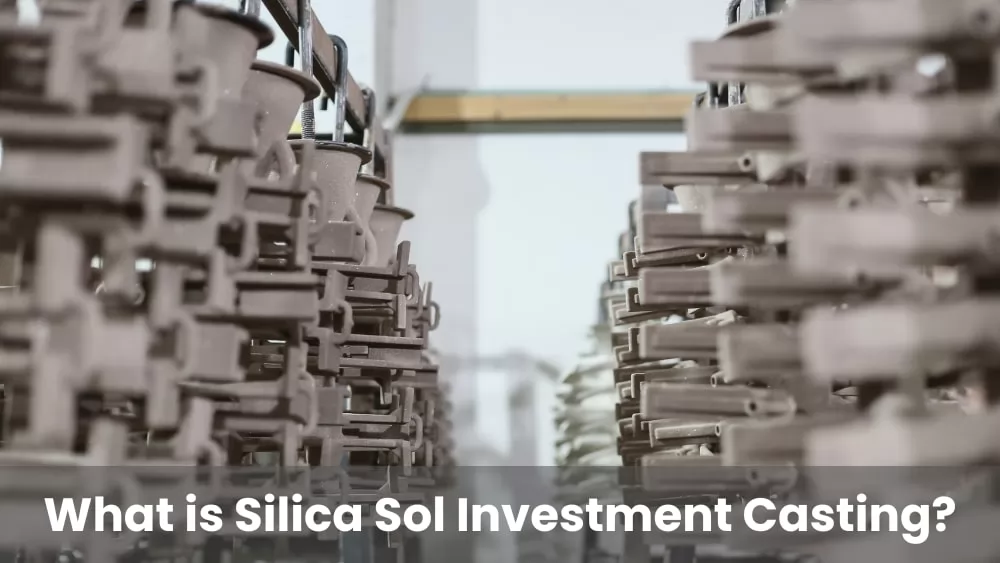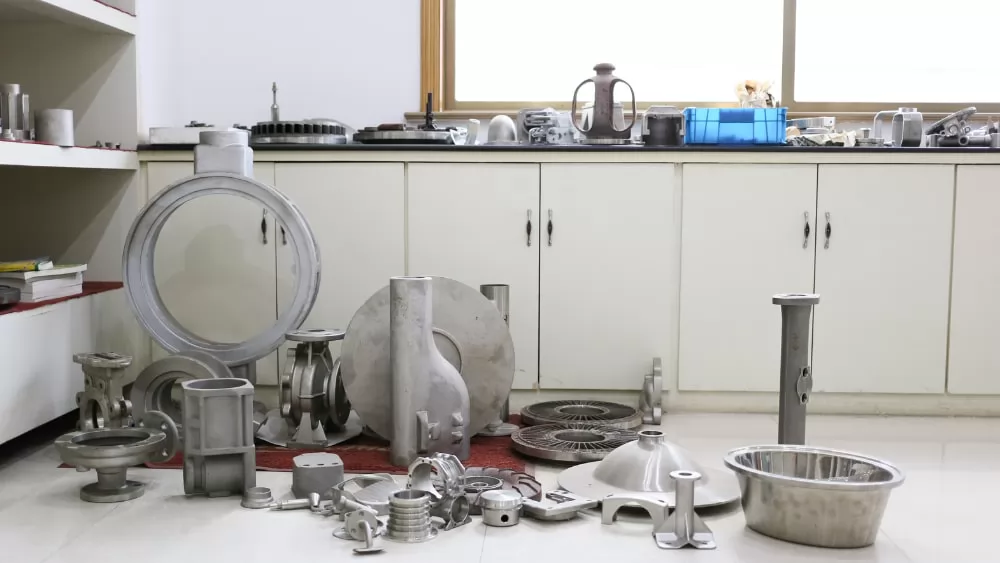
Silica sol casting is a form of investment casting. The process is very similar except that the investment mould is made from silica sol zircon sand mixed with refractory powder.
The silica sol is usually used for shell-building during the lost wax casting process due to its high accuracy and precision. Together with the water glass casting process, silica sol plays an important role in precision investment casting foundry.
From this article you will learn:
- What is Silica Sol Investment Casting?
- Why use Silica Sol Investment Casting?
- Application of Silica Sol Casting
- Silica Sol Investment Casting Products
- Introduction to the Silica Sol Casting Process
- Advantages of Silica Sol Casting
- Basic Parameters of Silica Sol Casting
- Silica Sol Investment Casting Vs Water Glass Investment Casting
- Why Choose Besser Silica Sol Casting Services
1. What is Silica Sol Investment Casting?
Silica sol casting is the casting process that uses silica sol (silica solution) as the binder material to build the casting mold. The metal castings produced by silica sol casting have fine surfaces and high accuracy and the general dimensional tolerance grade is up to CT4 - CT6. And this process is the main investment casting process of RMC for stainless steel castings and alloy steel castings.
2. Why use Silica Sol Investment Casting?
Silica sol investment casting offers several distinct advantages over other casting methods. Let’s break down why it’s often the go-to choice for industries requiring high-quality, precise parts:
-
Exceptional Surface Quality: Silica sol casting produces parts with smooth surfaces, reducing or eliminating the need for post-casting finishing such as grinding or polishing.
-
Dimensional Precision: The molds created using silica sol casting are incredibly precise, which allows manufacturers to meet tight tolerances and reduce material wastage from machining.
-
Intricate Part Design: This method is ideal for complex, intricate parts that require thin walls, sharp corners, and fine detailing—features that are often too challenging for traditional casting methods.
-
High-Temperature Resistance: Silica sol molds can withstand temperatures up to 2000°C, making them suitable for high-performance alloys and high-temperature applications.
-
Cost Efficiency in the Long Run: While silica sol casting might have a higher upfront cost compared to methods like water glass casting, the reduction in post-casting processing and the ability to produce complex parts directly leads to cost savings.
3. Application of Silica Sol Casting
Silica sol investment casting is widely used across various industries where high precision, excellent surface quality, and resistance to wear and corrosion are required. Some of its key applications include:
-
Aerospace: Components like turbine blades, brackets, and flight control mechanisms require intricate features and durability, making silica sol casting ideal for producing these parts.
-
Automotive: Critical engine parts, valve components, and high-performance engine blocks benefit from the fine detailing and high strength offered by this casting method.
-
Medical Devices: Silica sol casting is used to create surgical instruments, implants, and other components that require precise dimensions and biocompatibility.
-
Power Generation: Parts used in turbines and energy-efficient equipment often need to endure high stress and high temperatures, qualities achieved with silica sol casting.
-
Industrial Equipment: Components that require intricate geometries, like gears, pumps, and valves, are also typically made using this method.
4. Silica Sol Investment Casting Products

The products produced through silica sol investment casting are highly valued for their precision and surface finish. Examples of common products include:
-
Turbine Blades: Aerospace turbines demand components with exceptional aerodynamic properties, achieved through the fine detailing allowed by silica sol casting.
-
Pump and Valve Components: High-pressure pumps and valves require strong, durable components that are accurately cast to maintain the integrity of the systems.
-
Precision Engineering Components: Parts used in precision machinery, like gears or fasteners, benefit from the tight tolerances that silica sol casting offers.
-
Medical and Dental Parts: Devices like implants, dental crowns, and surgical instruments need to meet rigorous standards for both performance and biocompatibility.
Each product made through silica sol investment casting is thoroughly inspected and tested to meet industry standards, ensuring they are of the highest quality and reliability.
5. Introduction to Silica Sol Casting Process
The silica sol casting process involves several precise steps, each crucial in ensuring the final product’s quality. Here’s an overview of the typical process:
-
Pattern Creation: A metal die is used to create a wax pattern of the desired part. The wax pattern is then solidified and removed once it forms the correct shape.
-
Tree Assembly: Multiple wax patterns are assembled on a central tree, which allows several parts to be cast at once.
-
Shell Building: The wax tree is repeatedly dipped into a silica sol-zircon slurry, building up layers of fine silica to create the mold. The slurry is specially designed to offer a smooth finish with minimal porosity.
-
Drying: After each dipping, the shell is dried at a controlled temperature, which ensures proper bonding between the silica sol and refractory particles, forming a sturdy mold.
-
Wax Removal: The wax is melted and drained from the mold, typically at a temperature of around 200°C.
-
Mold Heating: The mold is then heated to over 1000°C to prepare it for metal pouring.
-
Metal Pouring: Molten metal is carefully poured into the mold. As the metal cools, it takes the shape of the pattern, including all the fine details and intricate designs.
-
Final Inspection: The casting is allowed to cool, and then inspected for accuracy, quality, and any defects.
6. Advantages of Silica Sol Casting
✔ Precision and Accuracy: Silica sol casting allows for the creation of parts with tight tolerances and intricate details.
✔ Superior Surface Finish: This casting method results in a smooth surface finish, often eliminating the need for post-processing such as polishing or grinding.
✔ Reduced Post-Casting Processing: Because of its high dimensional accuracy, machining requirements are minimal or non-existent.
✔ Versatility: Silica sol casting can be used for a wide range of metals, including stainless steel, carbon steel, alloy steel, and non-ferrous alloys.
✔ Durability: The parts produced are durable and have superior mechanical properties, which makes them suitable for high-performance applications.
✔ Cost-Effectiveness: While the initial investment may be higher, the reduction in finishing work and the improved casting quality leads to cost savings in the long run.
7. Basic Parameters of Silica Sol Casting
| Dimension Tolerance | ±0.1mm, Ct4~6; |
| Surface Finish | Ra6.3 |
| Wall Thickness Up to | 1mm |
| Unit Weight Extent | 0.1~100kg |
| Unit Size Limit | 0.01~0.5 Meters |
| Degree of Complexity | Very Complex |
| Machining | Less or None Due to Its Accurate Dimension |
| Production Period | Long |
| Production Cost | High |
8. Silica Sol Investment Casting Vs Water Glass Investment Casting
| Aspect | Silica Sol Investment Casting | Water Glass Investment Casting |
|---|---|---|
| Material Used | Silica sol as the binder | Water glass (sodium silicate) as the binder |
| Surface Finish | Superior, smoother surface finish | Rougher surface finish compared to silica sol |
| Dimensional Accuracy | Higher dimensional accuracy and precision | Lower dimensional accuracy, suitable for less intricate parts |
| Mechanical Properties | Better mechanical properties, higher strength | Adequate mechanical properties, lower strength |
| Casting Complexity | Suitable for complex and intricate shapes | Best for simpler, less intricate shapes |
| Application | Aerospace, automotive, medical, and precision engineering | General engineering, agricultural machinery, and construction |
| Cost | Higher cost due to superior quality and precision | Lower cost, more economical for large parts |
| Mold Life | Longer mold life, reusable for more cycles | Shorter mold life, fewer reuse cycles |
| Casting Size Range | Suitable for small to medium-sized castings | Can accommodate larger castings |
| Typical Alloys Used | Stainless steel, carbon steel, alloy steel, and non-ferrous metals | Carbon steel, low alloy steel, and ductile iron |
| Heat Resistance | Higher heat resistance, suitable for high-temperature applications | Lower heat resistance, less suitable for high temperatures |
| Environmental Impact | Lower environmental impact, more environmentally friendly | Higher environmental impact due to the use of water glass |
| Post-Casting Processing | Requires less post-casting processing due to smooth finish | Often requires more machining and finishing work |
Water glass investment casting uses sodium silicate as a binder, resulting in a rougher surface finish suitable for the cost-effective production of larger, less intricate components. In contrast, silica sol investment casting employs a colloidal silica solution for a finer surface finish and higher dimensional accuracy, making it ideal for precision applications in aerospace, automotive, and medical industries.
The choice between the two methods depends on specific requirements, including surface finish, dimensional accuracy, intricacy, and cost considerations.
9. Why Choose Besser Silica Sol Casting Services
As an outstanding investment casting company in China, we have the ability to produce products that meet international quality standards for you. With a large foundry and machining plant, we can provide you with a full range of casting services. From custom pattern design to finished castings and secondary operations including CNC machining, heat treatment and surface treatment, we have it all for you.
Besser Casting works collaboratively with clients to design the pattern and molding method for each custom casting. Request a Quote to get more information on how our casting service can match your project requirements.



